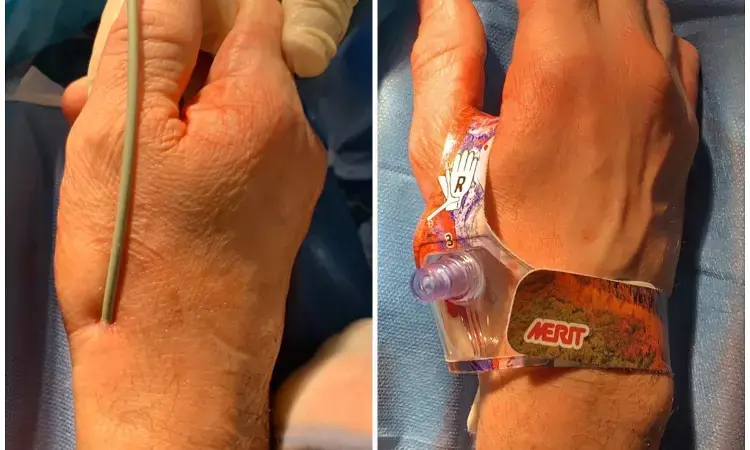- Home
- Medical news & Guidelines
- Anesthesiology
- Cardiology and CTVS
- Critical Care
- Dentistry
- Dermatology
- Diabetes and Endocrinology
- ENT
- Gastroenterology
- Medicine
- Nephrology
- Neurology
- Obstretics-Gynaecology
- Oncology
- Ophthalmology
- Orthopaedics
- Pediatrics-Neonatology
- Psychiatry
- Pulmonology
- Radiology
- Surgery
- Urology
- Laboratory Medicine
- Diet
- Nursing
- Paramedical
- Physiotherapy
- Health news
- Fact Check
- Bone Health Fact Check
- Brain Health Fact Check
- Cancer Related Fact Check
- Child Care Fact Check
- Dental and oral health fact check
- Diabetes and metabolic health fact check
- Diet and Nutrition Fact Check
- Eye and ENT Care Fact Check
- Fitness fact check
- Gut health fact check
- Heart health fact check
- Kidney health fact check
- Medical education fact check
- Men's health fact check
- Respiratory fact check
- Skin and hair care fact check
- Vaccine and Immunization fact check
- Women's health fact check
- AYUSH
- State News
- Andaman and Nicobar Islands
- Andhra Pradesh
- Arunachal Pradesh
- Assam
- Bihar
- Chandigarh
- Chattisgarh
- Dadra and Nagar Haveli
- Daman and Diu
- Delhi
- Goa
- Gujarat
- Haryana
- Himachal Pradesh
- Jammu & Kashmir
- Jharkhand
- Karnataka
- Kerala
- Ladakh
- Lakshadweep
- Madhya Pradesh
- Maharashtra
- Manipur
- Meghalaya
- Mizoram
- Nagaland
- Odisha
- Puducherry
- Punjab
- Rajasthan
- Sikkim
- Tamil Nadu
- Telangana
- Tripura
- Uttar Pradesh
- Uttrakhand
- West Bengal
- Medical Education
- Industry
Distal Radial Access, a Promising Approach for Minimally Invasive Procedures

The standard proximal radial approach (PRA) is now generally recommended over transfemoral access for both stable and acute patients in percutaneous myocardial revascularization. However, in a recent study, researchers have found that distal radial approach (DRA) is better than PRA in preventing the radial artery occlusion (RAO). The study findings were published in the JACC: Cardiovascular Intervention in February 2021.
The standard proximal radial approach (PRA) from the wrist has many advantages over the femoral approach, especially for significant reduction of access site bleeding and vascular complications. Some observational studies have shown that distal radial access has a low rate of RAO, but this had not previously been compared against the standard proximal (conventional) approach in a randomized clinical trial. Therefore, Dr Guering Eid-Lidt and team conducted a study to compare the rate of proximal radial artery occlusion (RAO) with Doppler ultrasound between distal and conventional radial access 24 h and 30 days after a trans-radial coronary procedure.
It was a prospective, comparative, longitudinal, randomized study of 282 patients. Researchers randomized them to either proximal radial access (n = 142) or distal radial access (n = 140) and evaluated the superiority of the distal approach in the prevention of PRAO with Doppler ultrasound 24 hours and 30 days after a trans-radial coronary procedure.
In the per-protocol analysis, the researchers noted that the rates of proximal RAO (PRAO at 24 h and 30 days were 8.4% and 5.6% in the proximal group and 0.7% and 0.7% in the distal group, respectively (24 h: odds ratio [OR]: 12.8; 30 days: OR: 8.2).
In an intention-to-treat analysis, they noted that the 24-h and 30-day rates of PRAO were 8.8% and 6.4% for proximal radial access and 1.2% and 0.6% in the distal radial access group (24 h: OR: 7.4; 30 days: OR: 10.6).
The authors concluded, "Distal radial access prevents RAO in the proximal segment at 24 h and 30 days after the procedure compared with conventional radial access."
Editoral of this study further added, "Although this single-center trial with a moderate number of randomized patients has obvious limitations to draw a general recommendation for the routine practice, it is necessary to highlight its importance. If these results are confirmed by the ongoing large international multicenter randomized DISCO Radial (DIStal Versus COnventional RADIAL Access for Coronary Angiography and Intervention) trial, this will mean a significant next step in minimally invasive strategy, not only in percutaneous coronary catheterizations and interventions, but also for other endovascular procedures."
For further information:
Medical Dialogues Bureau consists of a team of passionate medical/scientific writers, led by doctors and healthcare researchers. Our team efforts to bring you updated and timely news about the important happenings of the medical and healthcare sector. Our editorial team can be reached at editorial@medicaldialogues.in.
Dr Kamal Kant Kohli-MBBS, DTCD- a chest specialist with more than 30 years of practice and a flair for writing clinical articles, Dr Kamal Kant Kohli joined Medical Dialogues as a Chief Editor of Medical News. Besides writing articles, as an editor, he proofreads and verifies all the medical content published on Medical Dialogues including those coming from journals, studies,medical conferences,guidelines etc. Email: drkohli@medicaldialogues.in. Contact no. 011-43720751


